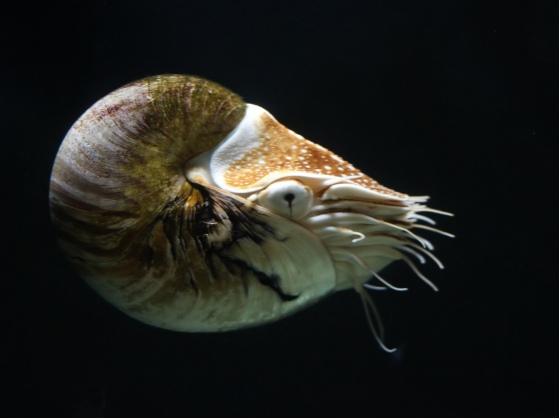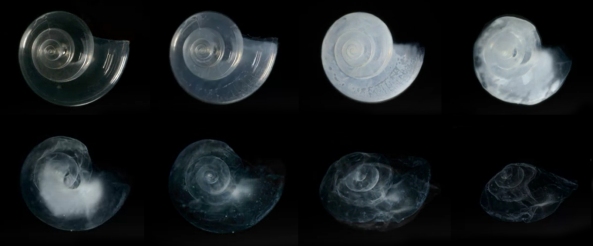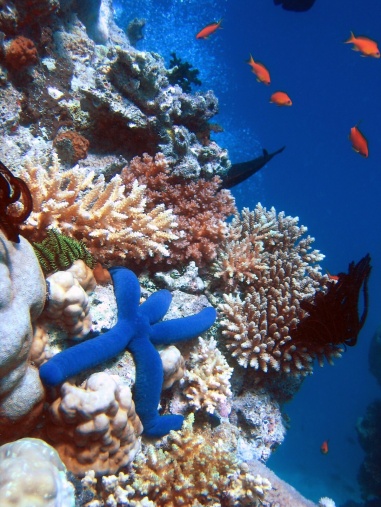What is Ocean Acidification?
Ocean acidification is simply the decrease in the pH of all of the oceans on Earth. But is it really that simple? The answer is no, it is not that simple. See, the ocean absorbs about 25% of the atmosphere’s CO2, and as atmospheric CO2 levels increase, so does the amount of CO2 that the ocean absorbs. Therefore, as the amount greenhouse gases increase, not only does the temperature of the ocean begin to rise, but the increase in CO2 levels causes the ocean’s pH levels to decrease. The rising acidic conditions cause a multitude of deleterious effects from limiting the formation of skeletons for marine organisms, to limiting coral growth, and corroding already existing coral skeletons.
While natural levels of carbon dioxide are fine, the excess CO2 that humans have managed to produce through burning fuels are the major problem. This is largely because when CO2 dissolves in the sea water, (CO2 + H2O-> H2CO3), it produces carbonic acid. While carbonic acid is not as strong as an acid, as say HCl, it still acts as an acid by donating protons, and interacting with surrounding molecules.
Why Does This Matter to Marine Animals?
Chemical reactions can be extremely sensitive to any fluctuation in pH levels, however, in the ocean, these pH change can affect marine life through chemical communication, reproduction, as well as growth. In particular, the building of the skeletons in marine life is extremely sensitive to any change in pH. Thus, the current increase in CO2 levels that have caused a more acidic environment, have greatly and negatively impacted the growth of new shells.

How so you ask? Because Hydrogen ions easily bond to carbonate (CO3 2-) molecules to create carbonic acid, and a marine animal’s shell consists of Calcium Carbonate (CaCO3). In order for marine animals to build shells, they take Calcium ions (Ca2+) with a carbonate molecule from the seawater surrounding it, to form the Calcium Carbonate needed to build their shells. So, instead of the carbonate giving all of it’s attention to Calcium, so that the marine animal can build it’s shell, it now pays more attention to the Hydrogen ion. In addition, Hydrogen ions have a greater attraction to carbonate, than a Calcium ion does to carbonate, and when two Hydrogen ions bind to carbonate, it produces a bicarbonate ion, in which a marine animal does not have the capability to extract only the carbonate ion. Ultimately, this limits marine animals from building any new shells for themselves, and even if the marine animal have the ability to build a new shell, it takes a lot of energy to do so, essentially taking away from other important processes and activities.

Not only can this affect the formation of new shells, but in the right conditions, it can corrode already existing shells. When there is too many Hydrogen ions floating around, and not enough molecules for them to bind to, they can actually start breaking the already existing Calcium Carbonate molecules apart, ultimately breaking down the marine animal’s shell that already exists!
Why Does This Matter to the Coral Reefs?
Similar to marine animals that build their homes with calcium carbonate, reef-building corals also use calcium carbonate to build their own homes and structures. These reef-building corals are also home to coral animals and other organisms. As mentioned before, the increased acidification greatly limits any further growth of new coral, as well as corrodes the any pre-existing coral reefs. If a coral reef has surpassed all the odds, and has been able to grow, it has proven to be an even weaker reef that is subject to natural erosion. It has been predicted that by the middle of the century that healthy coral reefs will be eroding more quickly than can be reproduced (which if you couldn’t have guessed, is really, really bad news!).

This is also bad news for the species that live in these coral reefs. If these species are not able to grow and development in a safe settlement, such as the coral reef, these larvae will be unable to reach adulthood, thus being unable to reproduce; ultimately leading to a mass extinction down the line.
Conclusion
While this blog post is limited, the large and vast effects of ocean acidification is far from limited. Ocean acidification does not discriminate, affecting not just shell-building marine animals and coral reefs and their tenants, but also deteriorating oysters, mussels, urchins, starfish, zooplankton, plants, algae, and fish are among just a few! It’s time to raise awareness and make some changes!



I really appreciate this excellent post. Ocean acidification is definitely a MAJOR concern! It is great how you emphasize just how important calcium carbonate is to all of marine life. And it is certainly another reason for why we need to greatly reduce CO2 emissions!
LikeLike
That is so sad about the marine snail’s shells breaking down or not growing properly 😦 I never thought about how ocean acidification affects shell builders. I always just think about how humans cause it and how easily preventable it is yet we still continue to drive our gas sucking cars and other forms of transportation. Your great background in chemistry made this very easy to read and still very informative. For one of my posts, I only had a small section on chemistry and it was so hard for me to write! My only suggestion is to maybe just explain what “skeletons for marine organisms” means in the first paragraph when you first mention it. You mention it later which is awesome but I was just confused for a few sentences. I really like how you concluded everything saying it affects so much more than you have time to talk about yet you provided a link to that information. I wonder if ocean acidification affects larger marine mammals such as whales and dolphins and also what effects does it have in turtle’s shells.
LikeLike
This is a great post. I also enjoy how you emphasized how important calcium carbonate is to all marine life. One correction I will make is that all of your chemical compounds are capitalized. The only time they should be capitalized is at the beginning of sentences. You included some great, vibrant images in here that make it easy for the reader to understand what you’re speaking about. I also really like how you added a conclusion, to wrap up your final thoughts and bring the reader back to the main purpose of your post. Great work!
LikeLike
Jaime, I really liked this post! I had no clue that the increase in CO2 levels causes a decrease in the oceans pH. I had never really learned anything about ocean acidification before I have read this and learned a lot. I never knew the impacts of an ocean with a lower pH can have on things such as shell formation and shell erosion. This can be quite worrisome considering these are protective aspects to many organisms lives. It is how they survive and fend off prey. I really liked how you went into the chemical portion but still kept it for people to be able to understand the importances of what is going on without a deep science background. Great job!
LikeLike
Interesting post Jaime, and very in depth. I was wondering if you found anything about ocean acidification and its effects on organisms with exoskeletons made of chitin instead of calcium carbonate? Whether that be direct effects like with the calcium carbonate, or indirect effects.
LikeLike